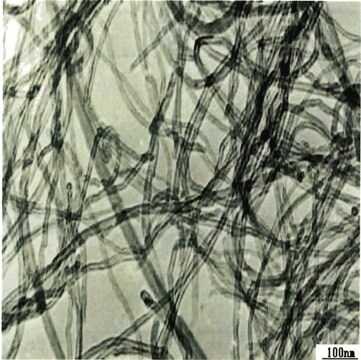750522
Carbon nanotube, single-walled
98% (Semiconducting), avg. no. of layers, 1
Sinônimo(s):
IsoNanotubes-S™, SWCNT, semiconducting, SWCNT, SWNT, Single wall carbon nanotube
About This Item
Produtos recomendados
Nível de qualidade
Ensaio
2% (Metallic)
98% (Semiconducting)
Formulário
solid
Características
avg. no. of layers 1
fabricante/nome comercial
NanoIntegris, Inc.
Comprimento
0.3-5 μm
diâmetro
1.2-1.7 nm
pf
3652-3697 °C (lit.)
densidade
1.7-1.9 g/cm3 at 25 °C (lit.)
cadeia de caracteres SMILES
[C]
chave InChI
OKTJSMMVPCPJKN-UHFFFAOYSA-N
Procurando produtos similares? Visita Guia de comparação de produtos
Categorias relacionadas
Descrição geral
Aplicação
- Electronics
- Sensors
- Composites
- Energy Storage
- Study of Life Science systems
Nota de preparo
Informações legais
Código de classe de armazenamento
11 - Combustible Solids
Classe de risco de água (WGK)
WGK 3
Ponto de fulgor (°F)
Not applicable
Ponto de fulgor (°C)
Not applicable
Escolha uma das versões mais recentes:
Já possui este produto?
Encontre a documentação dos produtos que você adquiriu recentemente na biblioteca de documentos.
Os clientes também visualizaram
Artigos
Electronic and Biomedical Applications of High-Purity Single-Walled Nanotubes (SWNTs)
Carbon nanomaterials (CNMs), such as single-walled carbon nanotubes (SWCNTs), multi-walled carbon nanotubes (MWCNTs), and graphene (Figure 1), have diverse commercial applications including lighter and stronger composite materials, improved energy storage devices, more sensitive sensors, and smaller transistors.
Boron nitride nanotubes (BNNT) are close structural analogs of carbon nanotubes (CNT), which are high aspect ratio nanotubular material, where carbon atoms are alternately substituted by nitrogen and boron atoms.
Carbon nanotubes (CNTs) have received much attention since their discovery in 1991 by Sumio lijima1 due to their excellent mechanical, electrical, and optical properties.
Protocolos
Single-Walled Carbon Nanotubes synthesized by the Super-Growth Method & their properties & applications, including dispersing SGCNTs, SGCNT-polymer composites & SGCNT-metal composites are discussed.
Global Trade Item Number
| SKU | GTIN |
|---|---|
| 750522-1MG | 4061826688663 |
Nossa equipe de cientistas tem experiência em todas as áreas de pesquisa, incluindo Life Sciences, ciência de materiais, síntese química, cromatografia, química analítica e muitas outras.
Entre em contato com a assistência técnica




